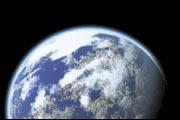Common ground
Can reverence for the earth bring us together across religious differences?
Common ground.
Perhaps that is the place to start. No matter what we think of one another’s religious beliefs or practices, we do all stand on the same ground. We share the same earth. The same sun rises and sets on all of us. Doesn’t this transcend our doctrinal differences?
Millennia ago, early peoples personified the sun and earth--made deities of them, worshiped them. Our modern scientific understanding of natural phenomena makes it unreasonable for us to do that. But surely we can share their reverence. Surely we can follow their example of respect for the earth, the air, the water--and be healthier and happier for it.
If there is a theme that runs through the history of rituals related to the earth’s seasons, it is renewal. The wheel turns and the old season gives way to the new, the old year to the new, the old life to the new. Each planting of seeds promises new possibilities. Each harvest brings sustenance for yet another year. Each fallow time regenerates the life of the soil. The sun deities retreat and return. The grain goddesses are lost and restored. The vegetation gods die and rise again. The cycle of life goes on and on, birth after death after birth. Perhaps what all the rituals celebrate is this continuity of life, the miraculous natural world that makes it possible, and our abiding connection to it.
For the ancients, interdependence was clear. Humans played as important a role in the renewal of the earth as the earth played in their renewal. On the eve of a new season’s beginning, the people (or the king in their name) fasted in order to purify not just their own bodies but the land itself. The fires that encouraged the fecundity of the land also made its people fertile. And the ritual mating of their leaders, replicating that of their deities of the earth and the sun, produced both children and crops.
For us moderns, distanced from the earth by technology, interdependence is not as clear. And we are paying the price: in polluted air and water, in soil erosion, in deforestation, and in global warming.
How different the condition of the planet might be if we allowed ourselves to be renewed at each turning of the wheel of the year, if we took the time periodically to celebrate the beauty and bounty of nature.
Celebrating the renewal of the earth gives us an opportunity to become new ourselves--to let go of old hurts and failures, to forgive ourselves and others, to get on with life as nature does, to open ourselves to hope and possibilities, to welcome the fertility of spirit that gives life its richness.
And because we all share the same earth, we can celebrate its renewal together, no matter what our theological differences may be. Recognizing our mutual bond with the earth can strengthen our bonds with one another and put into perspective the things that separate us. If together we respect our Mother Earth, will we not learn to respect one another and begin the work of peace?
The ground we stand on is holy--and it is our common ground.
Reprinted from In Nature’s Honor: Myths and Rituals Celebrating the Earth © 2005 by Patricia Montley, by permission of Skinner House Books. Available from the UUA Bookstore (see link in sidebar).








